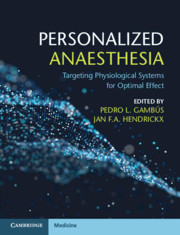Book contents
- Personalized Anaesthesia
- Personalized Anaesthesia
- Copyright page
- Contents
- Contributors
- Foreword
- Introduction
- Section 1 Basic Principles
- Section 2 Targeting Effects
- 7 Hypnotic Effect: Inducing Unconsciousness and Emergence from Anaesthesia
- 8 Analgesia: Effects on Response to Nociceptive Stimulation
- 9 Personalized Sedation and Analgesia
- 10 Respiratory Depression
- 11 Immobility
- 12 Effects on Brain Function
- 13 Targeted and Individualized Perioperative Medicine for Cognitive Dysfunction
- 14 Cardiac and Haemodynamic Function
- 15 Effects of Anaesthesia on Thermoregulation
- 16 Effects of Perioperative Management on Kidney Function
- 17 Effects on Liver Function
- 18 Effects on Fluid Balance
- 19 Ventilation during General Anaesthesia
- 20 Epilogue: Artificial Intelligence Methods
- Index
- References
7 - Hypnotic Effect: Inducing Unconsciousness and Emergence from Anaesthesia
from Section 2 - Targeting Effects
Published online by Cambridge University Press: 03 December 2019
- Personalized Anaesthesia
- Personalized Anaesthesia
- Copyright page
- Contents
- Contributors
- Foreword
- Introduction
- Section 1 Basic Principles
- Section 2 Targeting Effects
- 7 Hypnotic Effect: Inducing Unconsciousness and Emergence from Anaesthesia
- 8 Analgesia: Effects on Response to Nociceptive Stimulation
- 9 Personalized Sedation and Analgesia
- 10 Respiratory Depression
- 11 Immobility
- 12 Effects on Brain Function
- 13 Targeted and Individualized Perioperative Medicine for Cognitive Dysfunction
- 14 Cardiac and Haemodynamic Function
- 15 Effects of Anaesthesia on Thermoregulation
- 16 Effects of Perioperative Management on Kidney Function
- 17 Effects on Liver Function
- 18 Effects on Fluid Balance
- 19 Ventilation during General Anaesthesia
- 20 Epilogue: Artificial Intelligence Methods
- Index
- References
Summary
General anaesthesia (GA) is a reversible drug-induced state of altered arousal required for more than 60,000 surgical procedures each day in the USA alone, making it one of the most common manipulations of the brain and central nervous system [1]. It comprises several specific behavioural and physiological end-points – unconsciousness, amnesia, analgesia and akinesia – with concomitant stability of the autonomic, cardiovascular, respiratory and thermoregulatory systems [2, 3].
- Type
- Chapter
- Information
- Personalized AnaesthesiaTargeting Physiological Systems for Optimal Effect, pp. 103 - 116Publisher: Cambridge University PressPrint publication year: 2020

